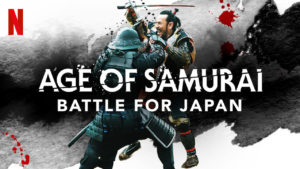Japan in the Sengoku period (1457-1615) was a living hell.
There was no central rule. The country was at the mercy of warlords, who were answerable to nobody. They waged battles for power and glory. This time was also called the Age of Warring States. A time of civil war, social turmoil, and political machinations.
The Age of Samurai – Battle for Japan is a docuseries that covers this scramble for power and glory. The life and death of three warrior leaders – Oda Nobunaga, Toyotomi Hideyoshi and Tokugawa Ieyasu – and their fluctuating fortunes forms the main narrative.

Pic courtesy – Youtube
All three warrior-leaders are ruthless on the battlefield, but this is not where their ultimate destiny is forged. It is the choices they make in unguarded moments – discretionary choices – that turn out to have a bigger impact. For Oda Nobunaga, it turns out to be how he treats his subordinates. For Toyotomi, it turns out to be the next thing to do after the war is won and the world is at his feet.
Leaders,no matter what the field, face the same vexing problems and are subject to the same vagaries of human nature. After unifying the country by means of war, Toyotomi has an army of warriors who have nothing to do. The challenge is not so different from what leaders face when the breakthrough project is over and the star team demands, what’s next.
Success creates its own problems, no doubt.
Toyotomi decides to send a Japanese army to invade China, but the way to China is through Korea. His army gets bogged down in Korea. No general is willing to risk his wrath and so battle reports from Korea to Japan are not truthful. Toyotomi is led to believe that he is winning the war in Korea. As a result, he loses all grasp of reality and makes wrong decisions. This scenario plays itself out in many a boardroom or corporate headquarters. A strong leader believes in being direct and forceful. He believes he is sending a tough message in censuring and sacking so-called inept people. Subordinates feel threatened and start being less truthful to save their skin.
In war and peace, human nature is the same.

Pic courtesy : Netflix
Tokugawa Ieyasu makes the most remarkable leadership call in the battle of Sekigahara. Ieyasu’s Eastern Army is facing the Western army – itself made up of clan-leaders contributing their own troops. One enemy clan leader, Kobayakawa Hideaki, conveys to Ieyasu that he will turncoat and defect during the battle to fight on behalf of Ieyasu’s Eastern army. The Western army plan is for Hideaki’s army to swoop down from a mountain and cut Ieyasu’s Eastern army down to size.
And then, the battle begins. It’s a stalemate. The Western Army signals to Hideaki to make his charge. As promised to Ieyasu, Hideaki ignores the order. But Hideaki does not attack his own side’s forces either!
There is tension in the air and nobody knows what’s going to happen next. At this pivotal moment, Ieyasu asks his troops to open fire on Hideaki’s army! This fire is really a blunt message to Hideaki – Make your choice. Its now or never! This forces Hideaki’s hand. He orders his troops to defect and attack the Western army,their own side!
This momentous decision of Ieyasu is better appreciated in the light of his own life. His entire life was a waiting game of patience, deferring to the stronger leader, be it Nobunaga or Hideyoshi. But when it was time to be decisive, he intervened. He made a choice. And made things happen.
The docuseries is worth a watch for those interested in a) history of other countries b) history of warfare c) leadership. Excess blood and gore. Viewer discretion is advised!